automatic transmission OLDSMOBILE BRAVADA 1998 Owners Manual
[x] Cancel search | Manufacturer: OLDSMOBILE, Model Year: 1998, Model line: BRAVADA, Model: OLDSMOBILE BRAVADA 1998Pages: 380, PDF Size: 19.2 MB
Page 65 of 380
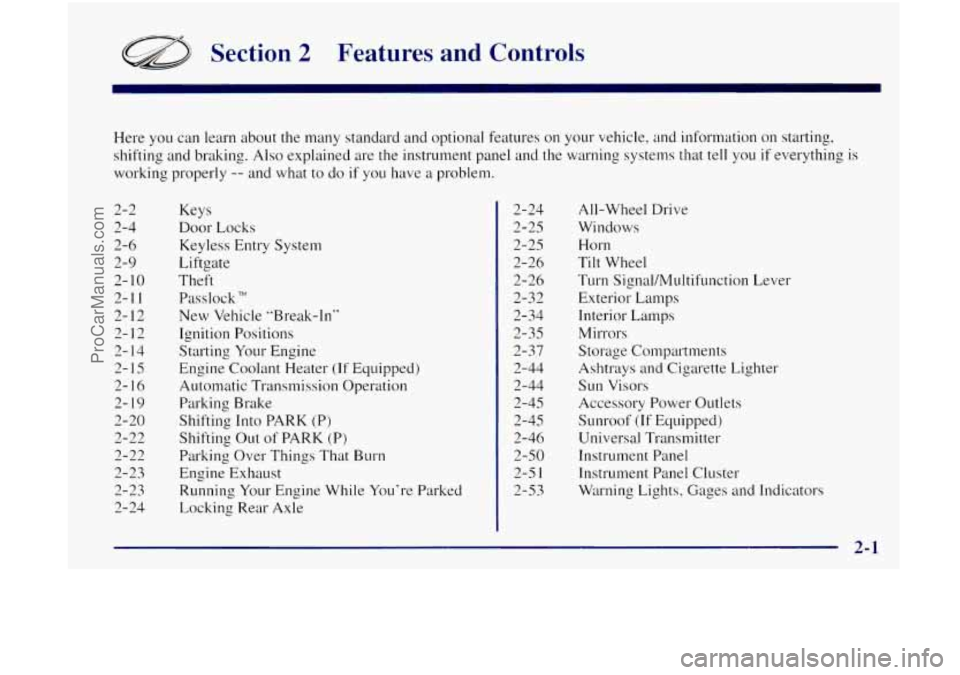
a Section 2 Features and Controls
Here you can learn about the many standard and optional features on your vehicle, and information on starting,
shifting and braking. Also explained are
the instrument panel and the warning systems that tell you if everything is
working properly
-- and what to do if you have a problem.
2-2
2-4
2-6
2-9
2-
10
2-1 1
2- 12 2- 12
2- 14
2- 15
2-16
2- 19
2-20
2-22
2-22
2-23
2-23
2- 24 Keys
Door Locks
Keyless Entry System
Liftgate
Theft Passlock
TM
New Vehicle “Break-In”
Ignition Positions
Starting Your Engine
Engine Coolant Heater
(If Equipped)
Automatic Transmission Operation
Parking Brake
Shifting Into PARK
(P)
Shifting Out of PARK (P)
Parking Over Things That Burn
Engine Exhaust
Running Your Engine While You’re Parked
Locking Rear Axle 2-24
2-25
2-25
2-26
2-26
2-32 2-34
2-35
2-37 2-44
2-44
2-45
2-45 2-46
2-50
2-5
1
2-53 All-Wheel Drive
Windows Horn
Tilt Wheel
Turn Signal/Multifunction Lever
Exterior Lamps
Interior Lamps
Mirrors
Storage Compartments Ashtrays and Cigarette Lighter
Sun Visors
Accessory Power Outlets
Sunroof (If Equipped)
Universal Transmitter Instrument Panel
Instrument Panel Cluster
Warning Lights, Gages and Indicators
ProCarManuals.com
Page 71 of 380

Operation
When you press UNLOCK. the driver's door will
unlock automatically, the parking lamps will flash and
the interior lights will go on.
If you press UNLOCK
again
within three seconds, the remaining doors will
unlock, the parking lamps will flash and the interior
lights
will go on. Press LOCK to lock all the doors.
Press LOCK again and the horn will chirp.
Press the
REAR button twice within three seconds to
unlock the rear liftgate glass, the parking larnps will
flash and the interior lights will go on. The transmission
must be
in PARK (P) or NEUTRAL (N).
Remote Panic Alarm
When the button with the horn symbol on the key
transmitter
is pressed, the horn will sound and the
headlamps and taillamps will flash for
up to two
minutes. This can
be turned off by pressing the
horn button again, waiting for 30 seconds, or
starting the vehicle.
Matching Transmitter(s) To Your Vehicle
Each remote keyless entry transmitter is coded to
prevent another transmitter from unlocking your vehicle.
If a transmitter is lost or stolen, a replacement can be purchased through your retailer. Remember
to bring
any
remaining transmitters
with you when you go to your
retailer. When the retailer matches the replacement
transmitter
to your vehicle. any remaining transmitters
must
also be matched. Once your retailer has coded the
new transmitter, the lost transmitter will
not unlock youI
vehicle.
Each vehicle can have only two transmitters
matched
to it.
Battery Replacement
Under normal use, the battery in your remote keyless
entry transmitter should
last about two years.
You can tell the battery is weak
if the transmitter won't
work at the normal range
in any location. If you have to
get close to your vehicle before the transmitter works,
it's probably time
to change the battery.
I NOTICE:
When replacing the battery, use em nat to touch
any of the circuitry. Static from your body
transferred to these surfaces may damage
the transmitter.
2-7
ProCarManuals.com
Page 74 of 380
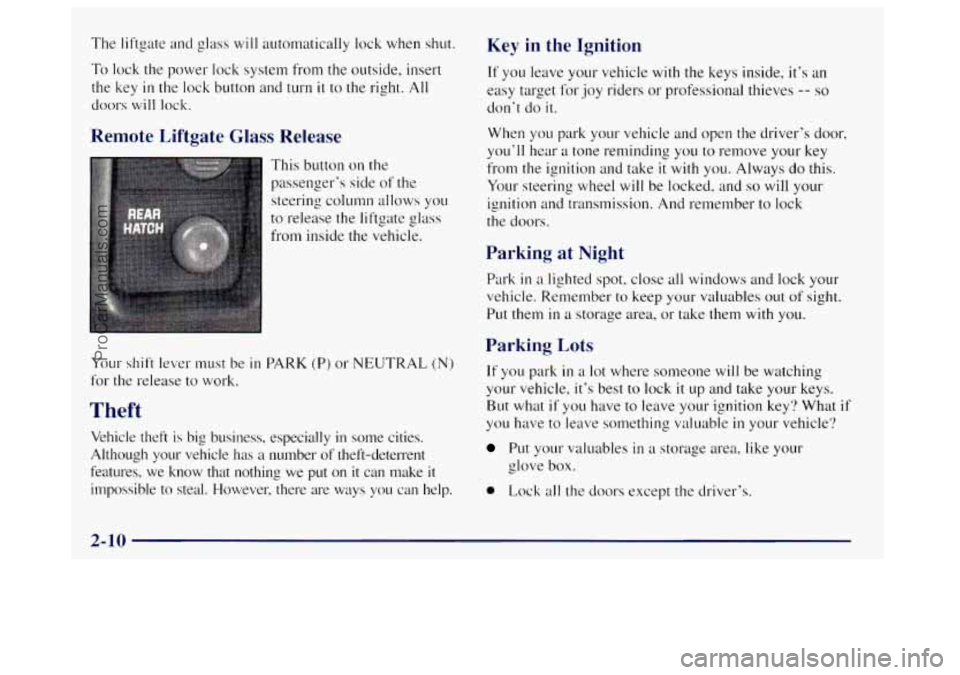
The liftgate and glass will automatically lock when shut.
To
lock the power lock system from the outside, insert
the key
in the lock button and turn it to the right. All
doors will lock.
Remote Liftgate Glass Release
This button on the
passenger’s side
of the
steering column allows you
to release the liftgate glass
from inside
the vehicle.
Key in the Ignition
If you leave your vehicle with the keys inside, it’s an
easy target for joy riders or professional thieves
-- so
don’t do it.
When you park your vehicle and open the driver’s door,
you’ll hear
a tone reminding you to remove your key
from the ignition
and take it with you. Always do this.
Your steering wheel
will be locked, and so will your
ignition and transmission. And remember to lock
the doors.
Parking at Night
Park in a lighted spot, close all windows and lock your
vehicle. Remember
to keep your valuables out of sight.
Put
them in a storage area, or take them with you.
Your shift lever must be
in PARK (P) or NEUTRAL (N)
for the release to work.
Theft
Vehicle theft is big business, especially in some cities.
Although your vehicle
has a number of theft-deterrent
features, we know that nothing we put
on it can make it
impossible to steal. However, there are ways you can help.
Parking Lots
If you park in a lot where someone will be watching
your vehicle, it’s best to lock
it up and take your keys.
But what
if you have to leave your ignition key‘? What if
you have to leave something valuable in your vehicle?
Put your valuables in a storage area, like your
glove box.
0 Lock all the doors except the driver’s.
2-10
ProCarManuals.com
Page 80 of 380
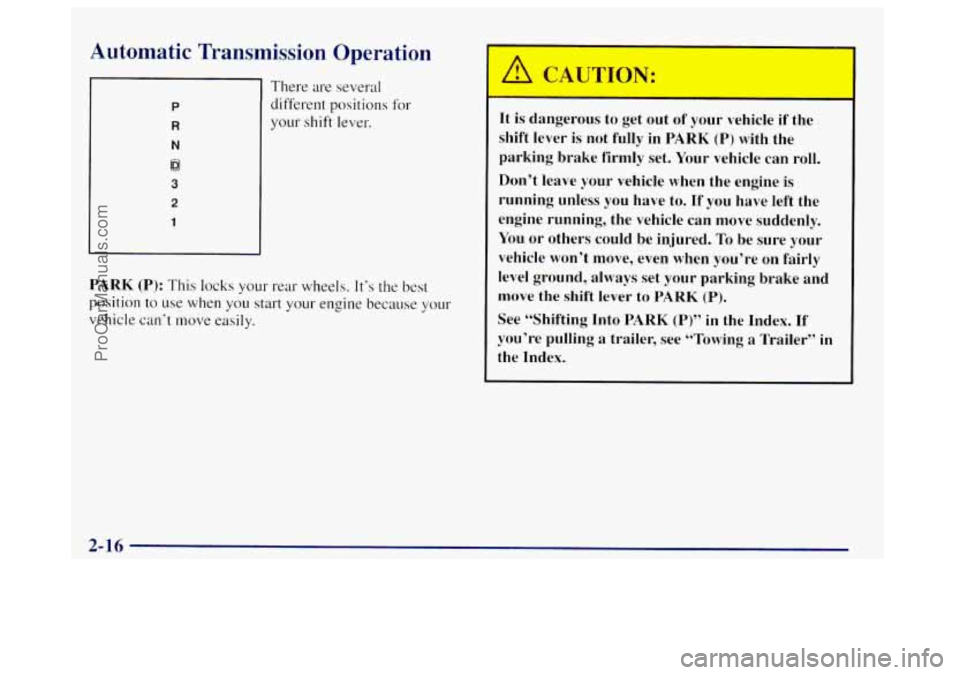
Automatic Transmission Operation
P
R
N
0
3
2
1
There are several
different positions for
your shift lever.
PARK (P): This locks your rear wheels. It’s the best
position to use when you start your engine because your
vehicle
can‘t move easily.
r
It is dangerous to get out of your vehicle if the
shift lever
is not fully in PARK (P) with the
parking brake firmly set. Your vehicle can roll.
Don’t leave your vehicle when the engine is
running unless you have to. If you have left the
engine running, the vehicle can move suddenly.
You or others could be injured. To be sure your
vehicle won’t move, even when you’re
on fairly
level ground, always set your parking brake and
move the shift lever to
PARK (P).
See “Shifting Into PARK (P)” in the Index. If
you’re pulling
a trailer, see “Towing a Trailer” in
the Index.
ProCarManuals.com
Page 86 of 380
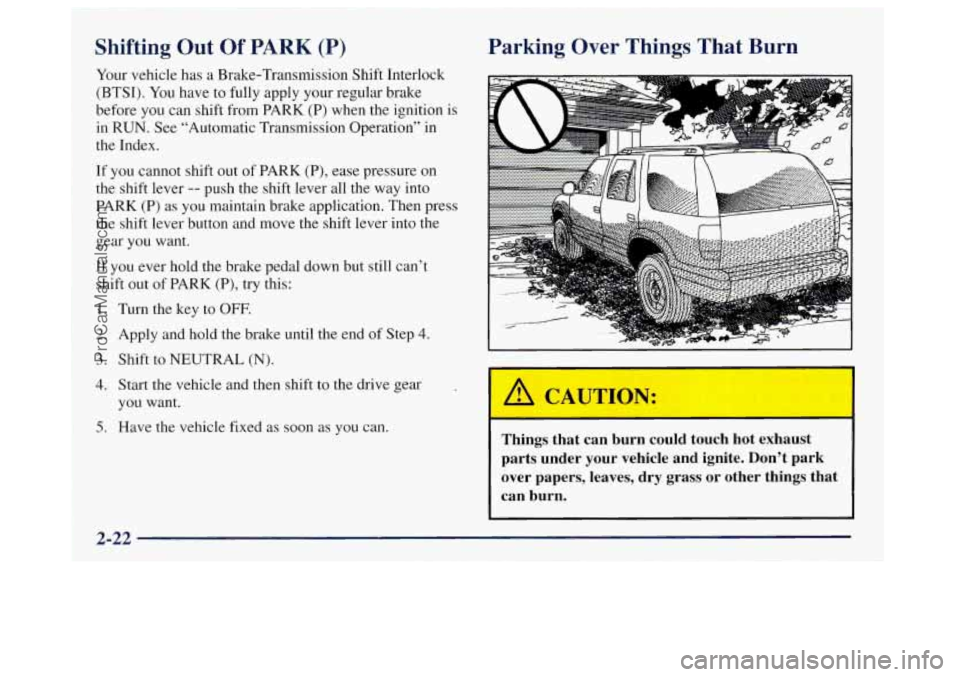
Shifting Out Of PARK (P)
Your vehicle has a Brake-Transmission Shift Interlock
(BTSI).
You have to fully apply your regular brake
before
you can shift from PARK (P) when the ignition is
in
RUN. See “Automatic Transmission Operation” in
the Index.
If you cannot shift out of PARK
(P), ease pressure on
the shift lever
-- push the shift lever all the way into
PARK
(P) as you maintain brake application. Then press
the shift lever button and move the shift lever into the
gear you want.
If you ever hold the brake pedal down but still can’t
shift
out of PARK (P), try this:
1. Turn the key to OFF.
2. Apply and hold the brake until the end of Step 4.
3. Shift to NEUTRAL (N).
4. Start the vehicle and then shift to the drive gear
you want.
5. Have the vehicle fixed as soon as you can.
Parking Over Things That Burn
I I
Things that can burn could touch hot exhaust
parts under your vehicle and ignite. Don’t park
over papers, leaves, dry grass or other things that
can burn.
2-22
ProCarManuals.com
Page 204 of 380

When You Are Ready to Leave After
Parking
on a Hill
1. Apply your regular brakes and hold the pedal down
while you:
Start your engine;
0 Shift into a gear; and
0 Release the parking brake.
2. Let up on the brake pedal.
3. Drive slowly until the trailer is clear of the chocks.
4. Stop and have someone pick up and store the chocks.
Maintenance When Trailer Towing
Your vehicle will need service more often when you’re
pulling
a trailer. See the Maintenance Schedule for more
on this. Things that are especially important in trailer
operation are automatic transmission fluid (don’t
overfill). engine
oil. axle lubricant, belt, cooling system
and brake adjustment. Each
of these is covered in this
manual, and‘the Index will help you
find them quickly.
If you’re trailering, it’s a good idea to review these
sections before you start your trip.
Check periodically to see that all hitch nuts and bolts
are tight
,
4-52
ProCarManuals.com
Page 210 of 380

2. Get the vehicles close enough so the jumper cables
can reach, but be sure the vehicles aren’t touching
each other.
If they are, it could cause a ground
connection you don’t want. You wouldn’t be able to
start your vehicle, and the bad grounding could
damage the electrical systems.
To avoid the possibility of the vehicles rolling, set
the parking brake firmly
on both vehicles involved in
the procedure. Put an automatic transmission vehicle
in
PARK (P) and a manual transmission vehicle in
NEUTRAL (N).
3. Turn off the ignition on both vehicles. Unplug
unnecessary accessories plugged into the cigarette
lighter, or accessory power outlets,
if you have this
option. Turn
off all lamps that aren’t needed as well
as radios. This will avoid sparks and help to save
both batteries. In addition,
it could save your radio!
NOTICE:
If you leave your radio on, it could be badly
damaged. The repair wouldn’t be covered by
your warranty.
An electric fan can start up even when the engine
is not running and can injure you. Keep hands,
clothing and tools away from any underhood
electric fan.
5-4
ProCarManuals.com
Page 238 of 380

b
NOTICE:
When the compact spare is installed, don’t take
your vehicle through an automatic car wash with
guide rails. The compact spare can get caught on
the rails. That can damage the tire and wheel,
and maybe other parts
of your vehicle.
Don’t use your compact spare on other vehicles.
And don’t
mix your compact spare tire or wl~eel with
other wheels or tires. They won’t fit. Keep your spare
tire and its wheel together.
NOTICE:
Tire chains won’t fit your compact spare. Using
them can damage your vehicle and can damage
the chains too. Don’t use tire chains on your
compact spare.
If You’re Stuck: In Sand, Mud,
Ice or Snow
What you don‘t want to do when your vehicle is stuck is
to spin your wheels too fast. The method known
as
“rocking” can help you get out when you‘re stuck. but
you must use caution.
If you let your tires spin at high speed, they can
explode, and you or others could be in,jured. And,
the transmission or other parts
of the vehicle can
overheat. That could cause an engine
compartment fire or other damage. When you’re
stuck, spin the wheels as little as possible. Don’t
spin the wheels above 35 mph
(55 kmh) as shown
on the speedometer.
5-32
ProCarManuals.com
Page 243 of 380
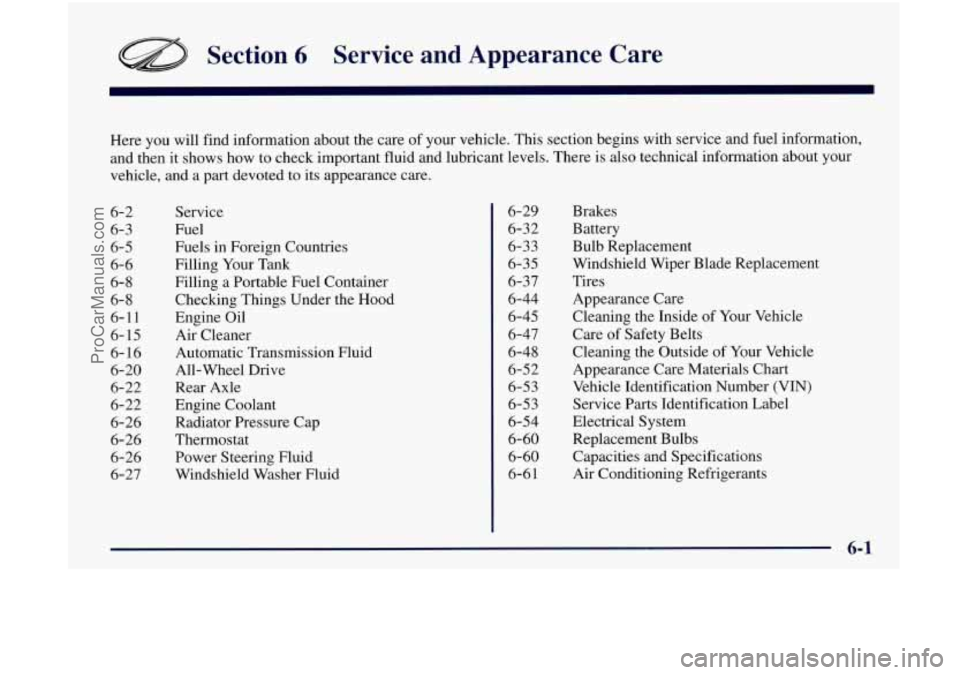
Section 6 Service and Appearance Care
Here you will find information about the care of your vehicle. This section begins with service and fuel information,
and then it shows how to check important fluid and lubricant levels. There is also t\
echnical information about your
vehicle, and a part devoted to its appearance care.
6-2
6- 3
6-5
6-6
6-8
6-8
6-11
6- 15
6- 16
6-20
6-22
6-22
6-26
6-26
6-26 6-27 Service
Fuel
Fuels in Foreign Countries
Filling Your Tank
Filling a Portable Fuel Container
Checking Things Under the
Hood
Engine Oil
Air Cleaner
Automatic Transmission Fluid
All-Wheel Drive
Rear Axle
Engine Coolant Radiator Pressure Cap
Thermostat
Power Steering Fluid
Windshield Washer Fluid
6-29
6-32
6-33
6-35
6-37
6-44
6-45
6-47
6-48
6-52
6-53
6-53
6-54
6-60 6-60
6-6
1
Brakes
Battery
Bulb Replacement
Windshield Wiper Blade Replacement
Tires Appearance Care
Cleaning the Inside of Your Vehicle
Care
of Safety Belts
Cleaning the Outside of Your Vehicle
Appearance Care Materials Chart
Vehicle Identification Number (VIN)
Service Parts Identification Label
Electrical System
Replacement Bulbs
Capacities and Specifications
Air Conditioning Refrigerants
ProCarManuals.com
Page 258 of 380
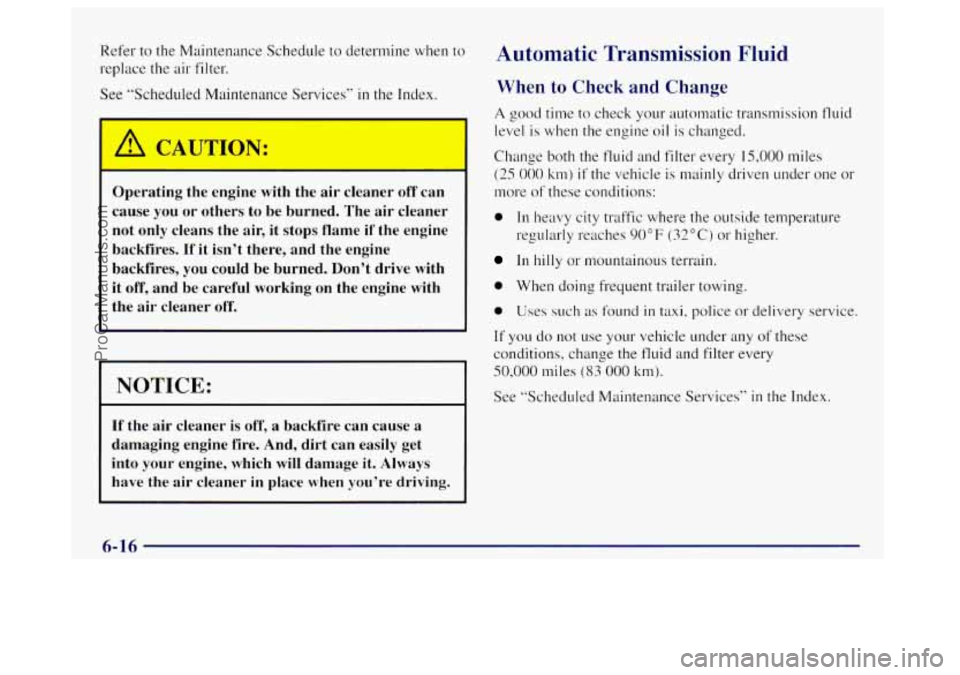
Refer to the Maintenance Schedule to determine when to
replace the air filter.
See “Scheduled Maintenance Services”
in the Index.
Operating the engine with the air cleaner off can
cause you or others to be burned. The air cleaner
not only cleans the air, it stops flame
if the engine
backfires.
If it isn’t there, and the engine
backfires,
you could be burned. Don’t drive with
it off, and be careful working on the engine with
the air cleaner off.
I NOTICE:
If the air cleaner is off, a backfire can cause a
damaging engine fire. And, dirt can easily get
into your engine, which will damage
it. Always
have the air cleaner in place when you’re driving.
Automatic Transmission Fluid
When to Check and Change
A good time to check your automatic transmission fluid
level
is when the engine oil is changed.
Change both the fluid and filter every
15,000 miles
(25
000 km) if the vehicle is mainly driven under one or
more
of these conditions:
0 In heavy city traffic where the outside temperature
regularly reaches
90°F (32°C) or higher.
In hilly or mountainous terrain.
0 When doing frequent trailer towing.
0 Uses such as found in taxi, police or delivery service.
If you do not use your vehicle under any of these
conditions, change the
fluid and filter every
50,000 miles (83 000 km).
See ”Scheduled Maintenance Services” in the Index.
6-16
ProCarManuals.com